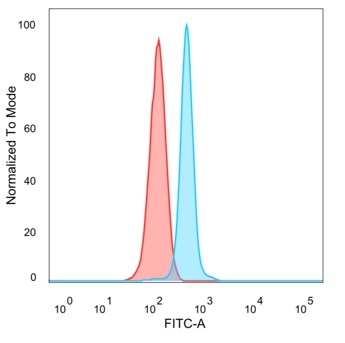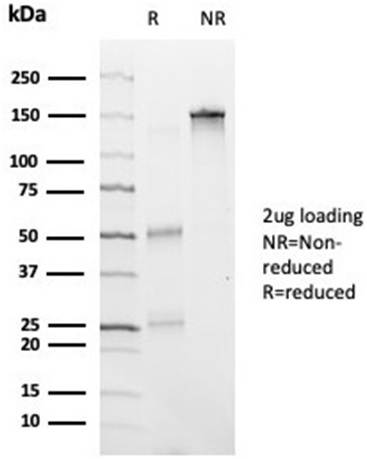Free Shipping in the U.S. for orders over $1000. Shop Now>>

Flow cytometric analysis of PFA-fixed HeLa cells. HDAC6 Mouse Monoclonal Antibody (PCRP-HDAC6-1A4) followed by goat anti-mouse IgG-CF488 (blue), unstained cells (red).

Immunofluorescence analysis of PFA-fixed HeLa cells. HDAC6 Mouse Monoclonal Antibody (PCRP-HDAC6-1A4) followed by goat anti-mouse IgG-CF488 (green).

SDS-PAGE Analysis of Purified HDAC6 Mouse Monoclonal Antibody (PCRP-HDAC6-1A4). Confirmation of Purity and Integrity of Antibody.

Analysis of Protein Array containing more than 19,000 full-length human proteins using HDAC6-Monospecific Mouse Monoclonal Antibody (PCRP-HDAC6-1A4). Z- and S- Score: The Z-score represents the strength of a signal that a monoclonal antibody (MAb) (in combination with a fluorescently-tagged anti-IgG secondary antibody) produces when binding to a particular protein on the HuProtTM array. Z-scores are described in units of standard deviations (SD's) above the mean value of all signals generated on that array. If targets on HuProtTM are arranged in descending order of the Z-score, the S-score is the difference (also in units of SD's) between the Z-score. S-score therefore represents the relative target specificity of a MAb to its intended target. A MAb is considered to specific to its intended target, if the MAb has an S-score of at least 2.5. For example, if a MAb binds to protein X with a Z-score of 43 and to protein Y with a Z-score of 14, then the S-score for the binding of that MAb to protein X is equal to 29.
In the intact cell, DNA closely associates with histones and other nuclear proteins to form chromatin. The remodeling of chromatin is believed to be a critical component of transcriptional regulation and a major source of this remodeling is brought about by the acetylation of nucleosomal histones. Acetylation of lysine residues in the amino terminal tail domain of histone results in an allosteric change in the nucleosomal conformation and an increased accessibility to transcription factors by DNA. Conversely, the deacetylation of histones is associated with transcriptional silencing. Several mammalian proteins have been identified as nuclear histone acetylases, including GCN5, PCAF (p300/CBPassociated factor), p300/CBP, HAT1, and the TFIID subunit TAF II p250. Mammalian HDAC1 (also designated HD1), HDAC2 (also designated RPD3) and HDAC3-6, have been identified as histone deacetylases.This enzyme deacetylates lysine residues in histones H2A, H2B, H3 and H4.
Notifications
There are no reviews yet.